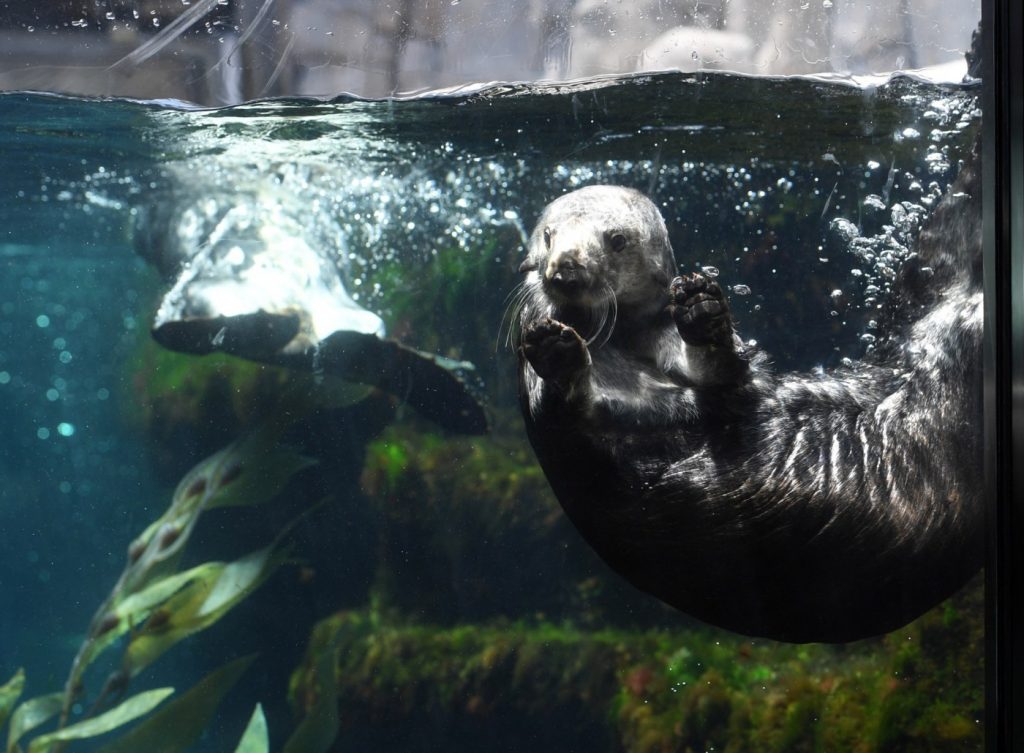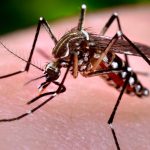MONTEREY — Behind the towering glass walls and shimmering cerulean exhibits at the Monterey Bay Aquarium, a sea otter named Selka paddles around an above-ground pool, a fluffy pup clutched to her chest. With unquestionable maternal diligence, she grooms, snuggles and shares food with this little one, despite the fact that it isn’t her baby. Selka has taken on the role of adoptive mother to the young otter that had been separated from its mother in the wild and was too young to fend for itself.
Selka is one of several participants in the aquarium’s long-running, first-of-its-kind surrogacy program. It pairs a rescued otter pup with one of the aquarium’s resident adult female otters, who raises the pup like her own and teaches it how to be an otter. Over the past two decades, the aquarium has successfully released over 75 otters that had been orphaned or abandoned as pups, but were well-prepared for life in the wild by their adoptive mothers. Selka herself was raised by a surrogate mother at the aquarium in 2012, after being rescued at just one week old.
Much of the program’s success stems from the otters’ instinctive willingness to raise an adopted pup, said Jess Fujii, who is the manager and principal investigator for the aquarium’s Sea Otter Program, which was established in 2002.
One of the Monterey Bay Aquarium staff members checks on the sea otter pups through a TV. (Arianna Nalbach – Monterey Herald)
“Other species may not have that same really strong maternal instinct to allow for these pseudo-adoptions, or fostering, to occur,” she said.
But in most cases, the female otters form strong maternal bonds with the pups, teaching them critical life skills such as diving and foraging for food.
Some pups are rescued at as young as a day old, said Fujii, and for their first few months of life, the pups are under nearly round-the-clock care by human staff and volunteers — who are gloved and masked to prevent the pups from habituating to their presence.
At around two months old, when it can start eating solid foods and diving underwater, a pup meets its potential surrogate mother. Staff carefully monitor both otters. In cases where there’s not an immediate connection, the female and pup are separated for a few days until they can try again.
“It can really vary from female to female how quickly that bond happens,” said Fujii, noting Selka seems to have particularly strong maternal instincts. “Pretty quickly, she’ll start sharing food with the pup and helping it get comfortable.”
Fujii says staff watch for signs of a developing bond, which often culminates in “that stereotypical picture of a female sea otter with a pup on her chest, swimming around the pool,” said Fujii. “That’s a really great sign that that bond has formed and that pup really recognizes that adult female as its mom.”
The pup continues to live with and learn from its otter mom until about six months of age, which is the typical weaning age for otters in the wild, said Fujii. Then the pup is separated from the foster, but remains at the aquarium for a few more months to continue socializing and practicing its foraging skills until it seems like it’s ready to be released.
History
“Currently, we’re still the only facility in the world that rescues sea otter pups with the intent of release back to the wild,” said Fujii. Partially because of the space requirements, but also because of how resource-intensive raising an otter pup is, she said.
In fact, rearing a tiny otter is such hard work that in the rare case a wild otter gives birth to twins, she usually has to choose just one of the pups to care for, Fujii said.
Nevertheless, staff and researchers have taken on the tough role of mothering otter pups since the aquarium’s earliest days. In 1984, the aquarium came across four stranded sea otter pups, aquarium Executive Director Julie Packard recently recounted.
Rosa swims by the glass for aquarium visitors in September 2022. She was the oldest sea otter on exhibit at the Monterey Bay Aquarium and died at age 24 last Wednesday. (Arianna Nalbach – Monterey Herald)
Related Articles
Elk return to the Sierra, their long-ago home?
Pygmy hippo Moo Deng is adorable and the internet loves her
Here are the 10 most common types of litter found on California’s beaches
Young, hungry female’s attack of young boy reveals much about state of California mountain lions
Why do my cats find catnip calming instead of invigorating?
At the time, no one had been able to keep infant pups alive, she said. But with the help of a local veterinarian (the late Tom Williams), aquarium staff succeeded in raising those first four pups to adulthood, said Packard.
“But they didn’t have any of the skills of surviving in the wild,” she said, so they became the first residents of the aquarium’s otter exhibit.
As more abandoned otter pups showed up, aquarium staff tried a more hands-on approach to help the pups adjust to life in the wild. A staff member would go out into the water with the otters, “swimming with them, diving with them, demonstrating what to do,” said Packard, “which had some success, surprisingly.”
But many of the pups still struggled to make it on their own, she said, especially because they were too comfortable around humans. Finally in 2001, someone had the idea of introducing an orphaned pup to an adult female otter they were rehabilitating. The program officially launched in 2002.
In 2020, the Aquarium of the Pacific in Long Beach became official partners in the surrogacy program, said sea otter program manager Megan Smylie. Over the past four years, they have built out additional pools for foster pairs and staff members have trained in Monterey to learn how to keep the otter pups from habituating to humans. The Aquarium of the Pacific also housed some non-releasable sea otters from Monterey, allowing Monterey Bay Aquarium to redirect resources to more releasable foster pups.
In April of this year, the Aquarium of the Pacific received their first pup and paired her with first-time surrogate mother Millie. This was Millie’s first time with a releasable pup at the aquarium, but “she’s been around a number of other juvenile pups and she’s always just ‘Mommy Mille,’” said Smylie. “She will mom anything that’s younger.”
Smylie described Millie’s patience with her new little one, who initially didn’t know what to make of this stranger trying to groom her and bring her food. “Millie just kept trying very calmly to offer food…she wasn’t overly pushy.” After just a few days of letting the pup warm up to her, “they became inseparable,” said Smylie.
That pup learned “all of the necessary skills from Millie,” said Smylie, and she is now back at Monterey Bay Aquarium, preparing to be released by practicing more complex socializing and foraging skills.
“It has been nothing but an honor to work with (the Monterey Bay Aquarium) and be a part of the amazing work that they do,” Smylie said. The facilities and staff in Long Beach have doubled the capacity of the surrogacy program, she said, which should now be able to rehabilitate roughly eight stranded sea otter pups a year.
Ecological impact
For the first 15 years of the program, foster-reared pups were released into Elkhorn Slough. During that time, Fujii said, the estuary’s otter population increased from about 20 to 100 otters, and an analysis published in the scientific journal Oryx in 2019 showed that more than half of population increase was because the surrogate pups survived and started their own families.
“When I started with the (Sea Otter) Program, surrogacy was already underway,” said Fujii, “but I’ve been able to visit Elkhorn Slough and see the changes in the ecosystem,” referencing how much healthier the eelgrass and the rest of the estuary has become because of the otters. As a keystone species, sea otters play critical roles in shaping their habitats, which is a major reason why rebuilding the sea otter population is so important.
Historical records have shown that the presence of sea otters has a positive relationship in helping kelp forests come back. (Brian Phan — Herald Correspondent)
Research shows that only a handful of otters need to be present to transform an ecosystem, said Smylie. “If we think that potentially eight otter pups are getting re-released back into their local habitats, it’s actually a pretty powerful number.”
In fact, since the repopulation of Elkhorn Slough has been so successful, the aquarium now releases sea otters into other habitats, including Morro Bay and around the Monterey Peninsula.
“It’s not just about saving the sea otters but really it’s about (asking), ‘How can we utilize the otters to transform and restore ecosystems?’” Smylie said.
How to help
Fujii said there are a lot of ways locals in the Monterey Bay area can help with otter rescue efforts, including reporting sightings of dead or distressed sea otters. Folks in Monterey County should call the Monterey Bay Aquarium Sea Otter Hotline at (831) 648-4840. Another way people can help otters, said Fujii, is just by giving them their space, especially when they’re resting.
Paddling just a bit closer to snap a photo of an otter napping in the sun might seem harmless, but it can actually have dangerous consequences for the animals.
Despite their playful reputation, being an otter is a lot of work, said Fujii. Unlike other marine mammals which have fatty blubber to keep them warm, otters just have fur — and a high metabolism — to stay warm in chilly Pacific waters.
A sea otter and pup are photographed in Elkhorn Slough on July 23. (Doug Duran/Bay Area News Group)
With a metabolic rate about three times higher than land mammals of their size, sea otters have to eat about 25 percent of their body weight every day, which means they spend a tremendous amount of energy just finding enough to eat. And since they don’t tend to store excess calories in the form of fat, their sun-baked naps help them conserve energy. Evading friendly humans wastes precious calories — which can quickly add up if they’re routinely being disturbed.
But knowing that a trip to Elkhorn Slough pretty much guarantees an otter sighting — even at a distance — “is a huge privilege that we have in this area” said Fujii. ”And knowing that our program helped contribute to that population’s growth is really encouraging for the work we do.”


